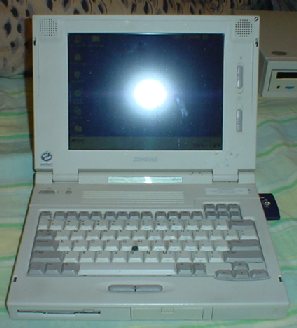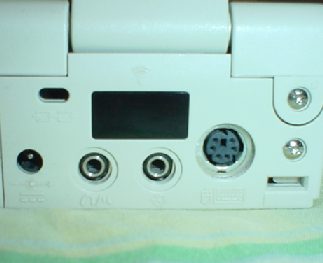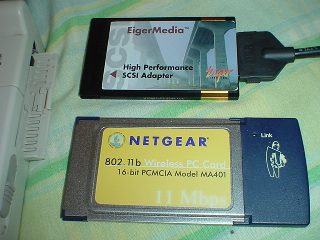You Are Here: Greyghost > Features Page > Compaq LTE 5000 Notebook Information
Compaq LTE 5000 Notebook --or-- "Anything's Worth 20 Bucks!"
Hey there! As you might imagine, this page and related resources are quite old
at this point and not especially actively maintained. (I still own this
computer and it works fine, apart from a dead clock and primary
battery. However, it doesn't exactly see a lot of use these days.) The
last time anything of any particular note changed or was updated here
happened back in March 18th, 2007. In 2018, I grabbed as much of the
supporting software as I could from HP's FTP site and made it available
here. In response to a reader's inquiry about the use of a CompactFlash
card in place of increasingly hard to find 2.5" IDE/PATA hard drives, I
updated the information about "disk manager" software and provided a
link to Ontrack's offering here in late 2021.
Those of you
looking for Compaq LTE 5000 series parts are likely in for quite a
challenge these days. It has been well over twenty years since these
computers were introduced to the market and all manufacturer support
ended long ago. By now many of these have gone to the trash or
recycling centers. I don't have any parts for these systems and I don't
know where you can get them. My first suggestion is try an online
auction site such as eBay. Persistence at flea markets, hamfests, and
web-based services such as Freecycle or Craigslist may also pay off.
Meanwhile, you
can still read and utilize the information supplied here. As with most
of the other web pages I've written and placed on this server, this
page will remain available for as long as I can possibly keep it that
way.
- WW, June 2016, January 2018, September 2021
Things to look at, learn from and possibly do:
Assorted Downloads (BIOS updates, device drivers, software fixes, etc.)
Compaq's Original Service Manual (seven megabytes)
LTE FAQ
Preface

Back in the late 1990s and early 2000s, I would frequently visit a
used business machines store. They had massive piles of equipment
everywhere, including lots and lots of computers. As I grew up, that
place was like heaven to me. It's also where I got a lot of the
equipment I used to learn and study computers. I truly hoped it would
never end. Of course, everything has a beginning, middle and
(unfortunately in this case) an end. There came a day (how's this for
timing?) during my high school career that I could slip away for part
of the school day so my dad and I planned to go to this store. When we
got there we found ourselves in the middle of their closing and moving
away. I grabbed lots of what remained, filled our station wagon, and
grabbed the LTE from a pile of laptops heading for the dumpster.
When it came time to pay for the machine, I bought it on a
"if it was in that pile, it probably doesn't work" basis for $20.
After
getting it home and cooking up a power supply, I was dismayed to see that the
machine appeared to be hanging at POST and the battery was clearly almost worn
out. I left it running at the POST screen and came back a few hours later. It
had finally booted into a copy of Windows 98 so I decided that maybe the LTE was worth fixing up.
Brief Post-Purchase History
Many years later, I can truly say that I got more than my money's worth from the Compaq LTE 5000.
I had intentions of making this computer available to other members of
my family, but about that time my primary laptop quit me and the 3rd
party warranty was not being honored by its provider. So, I sold my
main machine for parts and switched to the LTE after loading fresh
software on it.
The LTE survived a year of high school and many, many long car trips and
other excursions with only the loss of a floppy drive and the cooling fan
getting a little noisier than it should be now and then. To me
that's pretty impressive for a $20 machine with no warranty and no reason to
keep working day-to-day. Some other LTE machines that I have acquired have
donated parts to my LTE 5000, but not out of necessity...just out of desire to
have a better performing part.
Today it exists with a 12GB hard disk
taken from a Dell Latitude laptop that was destroyed by lightening ("Dude,
you're getting a....BLAM!!!) and a 150MHz processor card taken from an LTE 5400
that inherited the former 133MHz processor card. For a while I was using a
133MHz processor card plucked from an LTE 5300 with a dead mainboard.
Quirkiness (Hardware and Software)
I can't say the machine has
been without some strange behavior. As mentioned earlier I was dismayed at
the first power up to see the machine hanging right after the POST memory count.
From what I was able to gather at the time, the delay (often well over a minute
after the memory count!) was simply a result of the latest flash BIOS update.
That was a BIG relief!
It looks to me like the latest BIOS was rather
hastily written without much regard to whether or not it really
worked.
Many kind people have written in to say that earlier BIOS
revisions for the LTE don't have this "long delay at POST" problem, confirming
my suspicions that the last BIOS (07.32) was poorly written and has some kind of
a bug. Personally, I have switched my LTE 5000 to release 07.20 and it has
solved all problems with the slow POST issue for me. Your mileage may
vary.
WARNING: Flashing any computer's BIOS is a risk!
While it is very unlikely that anything could or would go wrong during the
process, errors can always occur. These errors could render your LTE unusable! I
can take NO responsibility whatsoever for any result of flashing your
LTE's BIOS! Do this strictly at your own risk or don't do it at
all!
The previous owner set a password for standby, and I didn't
discover it up until it was too late. It isn't much fun to delete the password
either. Finding instructions wasn't easy, but they did turn up on Compaq's site
after much searching. Turns out there is only one way to kill the password--and
it isn't pulling the clock/standby battery. You've got the dissassemble the
machine almost completely and flip a tiny jumper. Once you do that the password
is gone but then you must reassemble the machine. It isn't hard, but the tiny
size of everything makes it hard not to have screws wander off while you are
trying to tighten them.
The onboard LCD (containing various indicators)
acts totally messed up. While the picture below shows a generally correct
display, you may be able to see the ghosts of other characters showing up when
they shouldn't. This was finally replaced with an LCD from the same LTE 5300
that donated its processor card and now it works correctly.

Again, this is more of a minor aggravation than it is a true loss of
functionality. I just have to remember if I left the CAPS LOCK key on again...
:-)
The system's cooling fan has had some problems staying on the road.
After many years of heat and no doubt less than ideal cooling conditions, it
would appear that the bearings in the fan are simply worn out. Trouble is, the
fan is so small that a replacement has proven impossible to locate. Even if I
found another machine and took the fan from there chances are it would have the
same problem very soon.
UPDATE: I did find another fan (you guessed
it) in the LTE 5300. This was installed and all fan related problems have gone
away. Let's hope they stay away for some time to come!
The hibernation program as provided by Compaq doesn't work with FAT32
drives or any other non-FAT16 file system formatted drive*. In fact, it will
destroy all data on the
hard disk and wreck the partition table if you run the utility and/or try to
hibernate the machine afterward. This isn't much of a problem, because I just
never hibernate the machine. The FN+Standby keystroke may do the same if your
machine's BIOS believes that it has a hibernation file. Therefore--keep your
hands off of those keys and don't mess around with the hibernation utility if
you use an OS that does not utilize a FAT16 filesystem.
*
It is rumored that perhaps the hibernation utility is compatible with OS/2, but
I do not know if this includes OS/2 systems using HPFS partitions.
Every
now and then (especially on warm boots) the machine will operate exceptionally
slowly. I believe this is another BIOS related problem in that something may not
be getting properly reset upon warm booting. It does happen every once in a blue
moon on a cold boot though.
Good Points
The quirks in the hardware aren't really all that
serious if the features are more than enough to make up for them. The LTE 5000
has very decent hardware for a machine of its time.
Originally the
machine had a 3GB hard disk installed in it at some point to replace the stock
528 (?) MB drive. Someone also put the maximum of 74MB RAM in it as well. Not
bad for a $20 machine...
I have since installed a 12GB hard disk just because I had the good
fortune of getting it for nothing from another machine that suffered a
lightening hit. Those who want to do this should know that the latest
BIOS (07.32) does support drives up to 8GB natively and higher if you
use a disk manager program. While once freely available from hard drive
manufacturers, these, along with the problems they were intended to
solve, have vanished here in 2021. Fortunately, Kroll Ontrack granted
permission to distribute their disk manager software and you can download it here.
(I should probably mirror that sometime, if possible.) I would
recommend you choose the 9.57 release, although the LTE may work with
the later 10.46 version.
Disk Managers are small software shims that load before any operating
system, and correct for any deficiences or limits in a given BIOSes
ability to recognize hard drives beyond a certain capacity. I don't
know if they will work to resolve any such deficiences or oddities you
may encounter using solid state storage, such as CompactFlash card, in
a suitable adapter. If you try this, let me know if it worked for you!
The display panel is limited to 640x480, but unlike lots of other
laptops from that time, it can run in high (16 bit) color. While not
really a must by any means, it means no dithering or palette shifts
like happen on a 256 color adapter or mode. Video is provided with a
Cirrus 7543 controller and 1MB VRAM. This seems to be entirely
sufficient for anything you're likely to do with relatively "period
correct" display hardware.

Coolest of all is the IR port on the machine. No it's not really
needed, but it seems that fewer and fewer modern laptops are equipped
with IR. Too bad--it's really handy for those times when a file
transfer is needed and you just can't do it any other way. (I used the
LTE to send the entire set of Windows 98 installation files to a
ThinkPad 760EL, and it worked well despite being a study in what a long
wait is. In the years it's been since I did this, USB storage devices
and certainly the ports to which they connect have become ubiquitous.
Of course, there's very often no easy way, or any way at all, to add
USB ports to older computer hardware.)
While a Pentium 75
MHz processor is a bit overcome by the task of decoding MP3 audio with the Windows
Media Player 6.4, or even WinAmp 2.83 it certainly does work and the machine's
audio output works really well fed into earphones or a line input. Even the
onboard speakers aren't too bad.
ACPI? What ACPI? Who Needs
ACPI?
Another good point of the machine is the standby feature.
Seems that lots of Windows 98 machines (especially those with a PhoenixBIOS)
have real problems either going to sleep (rarely) or waking up (far, far more
likely!). LTE does have the occasional problem waking up, but it isn't so bad
that I'd call the standby feature unreliable.
(In case you were
wondering, no, the LTE 5000 does not support ACPI*.)
The best point of
all however is the "forcefullness" of the standby routine. Sometimes Windows 98
decides it is going to be stupid and not let the machine go to sleep,
complaining of a device driver or program not allowing the system to standby.
With most machines you can't rectify this problem short of a reboot and another
try. Thankfully the LTE was built before a standby function 'cared' what a
program or device driver thought of being put into standby and when the button
is pressed to do so, the machine WILL go to sleep.
It is also very nice
that once it is sleeping it will stay that way. I've seen many a laptop or other
computer that would "wake up" if something happened like a modem ringing or just
because it was inconvenient. Many hardware manufacturers could take a cue from
this aspect of the LTE 5000, in my opinion and make a computer that goes to
sleep when the standby button is pressed and doesn't wake up until the user
pushes the button again.
Hardware I've Used With The Machine

Generally I've used my LTE with only the onboard peripherals.
Usually I have only had a NIC installed in one of the PCMCIA slots.
I've
used many different NICs over time, starting with an Eiger card, moving to a
dual-purpose 3COM card, and finally making the jump to a Xircom 10/100 card. Now
I've set up a wireless access point and while the first attempt with a Linksys
WPC-11 card did not go well, a Netgear MA401 has worked excellently. I misplaced
the MA401 a while back, so now I'm using a Microsoft MN-520.
I suppose it
was more poor design than anything else that made the Linksys card fail. In the
bottom PCMCIA slot it wouldn't even register as a card (just a blank "something"
showed up as being installed) and when in the top slot, it didn't work
reliably.
From time to time I also use an Eiger SCSI PCMCIA card. I've
used it with a flatbed scanner, a 6 disc CD changer, external ZIP drive, and at
present, an IBM 3510 enclosure with CD-ROM II drive installed. All devices have
worked well with the adapter.

Conclusion
To be honest, I typed this up when I was bored, so
maybe it's kind of pointless to read, but I'm pleased at having gotten such a
good laptop for only $20. And who knows--maybe this page could be useful to
someone else presented with the chance to get a similar computer in a similar
situation?
In March of 2005 I finally broke down and bought a brand new laptop...a
Dell Latitude D800. To be quite honest, I hope it lasts every bit as
long as the LTE managed to, if not longer. The LTE 5000 is still
running today (03/2007) and has been reconfigured to work as a portable
Wi-Fi/Ethernet/Token Ring network testing tool. It does this job very
well. I will be rather disappointed if the Dell cannot manage the
stellar reliability record established by my trusty old LTE 5000!
* ACPI - Advanced Crap causing Power Irritations, just in
case you were wondering. ;-)
Go Back>
Copyright © 2001-2021 by William R. Walsh. Some Rights
Reserved. Please see the top level page of this server for information
concerning your rights to reproduce this page and reuse it in other
works. Reproduction in whole is generally allowed on the condition that
no advertising is displayed with this material and no items of value
are exchanged for access to this material, other than as reasonably
necessary to cover connection time or consumable expenses. Reproduction
in part requires permission.





